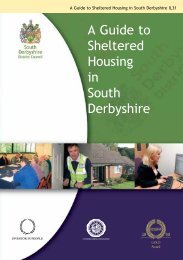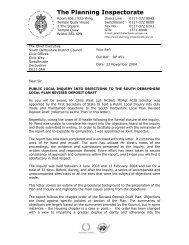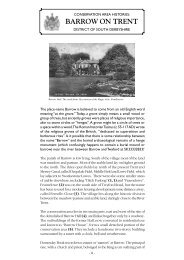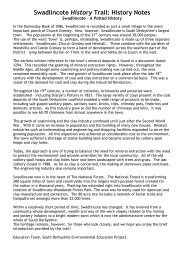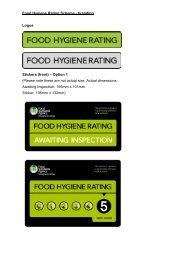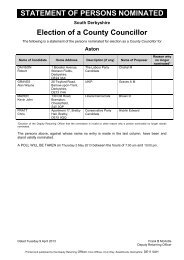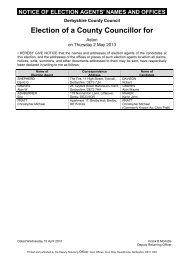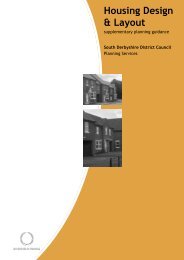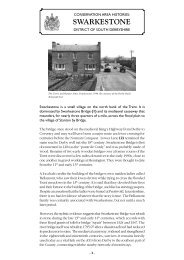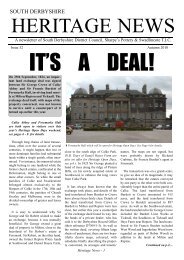Housing Strategy 2009-2014 - South Derbyshire District Council
Housing Strategy 2009-2014 - South Derbyshire District Council
Housing Strategy 2009-2014 - South Derbyshire District Council
You also want an ePaper? Increase the reach of your titles
YUMPU automatically turns print PDFs into web optimized ePapers that Google loves.
<strong>South</strong> <strong>Derbyshire</strong> <strong>District</strong> <strong>Council</strong> <strong>Housing</strong> <strong>Strategy</strong> <strong>2009</strong> – <strong>2014</strong><br />
sector was that set by PSA7, where 65% of all dwellings occupied by vulnerable<br />
residents should be made decent by 2006/07. In practice, the most challenging<br />
target was the 70% to be met by 2010/11. Although PSA7 target no longer exists,<br />
it is still a CLG 21 Departmental Strategic Objection under DSO2, 2.8.<br />
8.3.3 The district stock condition survey carried out in <strong>2009</strong> 22 estimated that <strong>South</strong> <strong>Derbyshire</strong><br />
does not meet either target as 64.1% of vulnerable households live in decent homes.<br />
An estimated shortfall of 396 homes occupied by vulnerable households need to be<br />
made decent to make up the shortfall. Current evidence shows that there are some<br />
areas in the district, particularly in the south of the district in the Seales and Linton wards<br />
where it is estimated that only 44.2% of vulnerable households homes are decent and<br />
the Swadlincote urban area where 62.4% of homes are decent.<br />
Key Issue: Tackling non-decent homes occupied by vulnerable<br />
households in locations with higher proportions of non-decent.<br />
8.4 Energy Efficiency and Fuel Poverty<br />
8.4.1 Fuel poverty is defined as when fuel costs are more than 10% of disposable<br />
income. In addition, the term ‘severe fuel poverty’ and ‘extreme fuel poverty’ are<br />
sometimes used to indicate where fuel costs are more than 20% and 30% of<br />
disposal income respectively. The <strong>2009</strong> <strong>District</strong> Stock Condition survey estimated<br />
that 12.3% (4,300) of private households were experiencing fuel poverty.<br />
8.4.2 The UK Fuel Poverty <strong>Strategy</strong>, published 2001, sets a government target to end the<br />
blight of fuel poverty in vulnerable households by 2010. Fuel poverty is caused by a<br />
combination of factors including poor energy efficiency of the home, high fuel costs<br />
and household income. Hence, only improving the energy efficiency of homes is<br />
unlikely to eradicate all cases of fuel poverty. The UK Fuel Poverty <strong>Strategy</strong> suggests<br />
a SAP of 65 as minimising the risk of fuel poverty. In April 2008 the average SAP of the<br />
council stock was 68. The average SAP rating for private housing was 53 in <strong>2009</strong>.<br />
8.4.3 Since 2003 the <strong>Council</strong> has carried out a wide range of energy efficiency improvement<br />
programmes including loft installation and providing households with free low energy<br />
light bulbs. It is likely that with rising fuel costs experienced in 2008 and predicted<br />
increase in unemployment due to the economy slowdown that fuel poverty will<br />
increase. A more holistic approach tacking all the factors affecting fuel poverty<br />
including low income should be considered.<br />
Key Issue: Improving energy efficiency alone is unlikely<br />
in the long-term to reduce fuel poverty and a more holistic approach<br />
to address all contributing factors should be considered.<br />
21<br />
CLG – Communities and Local Government.<br />
22<br />
CPC (<strong>2009</strong>) Private Sector <strong>Housing</strong> Condition Survey.<br />
29



